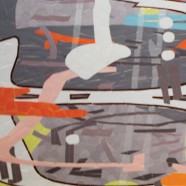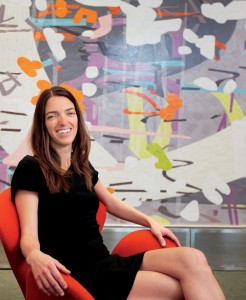
“I have always loved making things, craft-y sorts of things,” Ophelia says, “clothes, furniture, pottery — I was really into ceramics at Milton, for instance.” Slight and strong, both understated and definitively stylish in a textured black-on-black dress (“I wish I’d made it, but I didn’t,” she says), Ophelia explains how and why every detail matters in what she’s “making” today.
An architect with the firm Kuth Ranieri in San Francisco, Ophelia is working on creating a space where ideas will ignite, and moving nine companies of designers and contractors to work together, literally, and achieve an outrageous goal. Designing and executing a new Terminal 1 (T1), these collaborators will move San Francisco International Airport (SFO) steps closer toward being “the cleanest, greenest and most sustainable airport in the world.”
Not an airy sound bite, that mission drives a clear-headed business plan rooted in a pervasive culture at SFO. Just last June, a summit of airport commissioners and sustainability thought leaders named four “Big Hairy Audacious Goals” that the group considered key implementation steps. Reaching for number one (the best airport in the world by any metric) will require “reaching zero”: the airport will achieve net zero energy, net zero carbon emissions, and zero waste by 2020. Another “audacious” step commits SFO to model, educate, engage and influence all of its publics in sustainability.
 From the Airport Commission (an appointed city entity) and the airport director, John Martin, through employees, tenants, airlines and the San Francisco public, everyone believes that the vision is worth every effort, no matter how challenging, and is absolutely achievable.
From the Airport Commission (an appointed city entity) and the airport director, John Martin, through employees, tenants, airlines and the San Francisco public, everyone believes that the vision is worth every effort, no matter how challenging, and is absolutely achievable.
SFO gained status as a sustainability industry leader in part with the breakthrough renovations of Terminal 2 (2011) and upgrades to boarding area A and the east wing of Terminal 3. SFO wants travelers to shift their perceptions about spending time in an airport from painful to pleasant. Many travelers do admit exactly that: They’re surprisingly upbeat about their preflight, or between-flight time at SFO — the eating, shopping, working, thinking, people watching, noticing the art.
“For an architect,” Ophelia says, SFO is a “wonderful client.” She likes the aspirations, the openness to experimentation, the risk-brings-reward culture. “The airport leadership has an uncompromising quality standard,” she says, and they know that “the quality of the design that goes into the airport directly affects the revenues it generates.”
A highly popular history of architecture course at Brown University triggered Ophelia’s interest in architecture. She was a “philosophically oriented, literature and computer science major” there. During the summer before senior year, she tested her emergent interest in architecture at Harvard’s Career Discovery Program, before wrapping her life around pursuing a career in the field. The projects that summer “united a certain research orientation I liked to bring to things — learning about the site, environmental factors, people, program — and finding a solution, not necessarily a direct response, but something that complements what the building is trying to achieve in its space.”
After college, in San Francisco, looking for a job in user interface perhaps, she serendipitously ended up with a position at Robin Chiang & Company, a local architectural firm focused on BART, the San Francisco Muni (municipal railway) and SFO.
Ophelia has focused on “buildings and spaces that affect us collectively.” She says she “dislikes waste; loves efficiency. Buildings have the greatest potential to negatively affect their environment, and the same capability to benefit it. Done well, with the values of the relevant communities in mind, with an awareness of the surrounding fabric, they can provide an asset unlike any other.”
Her relationship with Robin Chiang continued for 14 years, through grad school at MIT and a Rose Architectural Fellowship. Last spring, Ophelia transitioned to Kuth Ranieri, a Local Business Entity (LBE) that is partnering with the international firm Gensler on T1 and other major projects at SFO.
SFO’s earlier success with Terminal 2 gave rise to confident, bold, expansive and expensive plans for the next five years. As it renovates and builds at a brisk pace, the Airport Commission has doubled down on three measurable outcomes: enhancing customer experience; generating revenue; and developing a coherent character to the whole campus, based on the airport’s values.
T1, a $1.7 billion project within SFO’s $4.4 billion capital plan, “is an absolutely enormous project,” Ophelia says, “with incredibly ambitious goals. So this terminal will be the first foray into a major undertaking.”
Ideas for Terminal 1, which today services Delta and Southwest, will be born in a massive work area known as the SFO Big Room. Ophelia is managing the design implementation of the Big Room, an “enabling project” as she calls it: a 30,000-square-foot space that will come to life inside a massive hangar.
The T1 project specs require that all the companies on the design team work under one roof, on the airport campus. The Big Room accommodates 196 workstations. More importantly, it must create spaces that inspire a raft of designers to work together. “We are one big team,” the Big Room design presentation asserts, “without big egos, but we want to highlight the diversity of thought and variety of experiences each of us brings to the table.”
A hybrid between an on-site mobile trailer and a highly productive beehive of professionals bent on achieving something brand new, the Big Room foments gritty intensity for five years, and then its job will be done. To succeed, it needs to provide various work environments — open-ended, private, visually communicative, inclusive, convening. People with vastly different work styles need conditions that enable their best work. The tone of the Big Room should be at once visually uplifting and seriously practical. Stages of the creative process need to be visible and inspirational, accessible for staff and for VIP visitors.
In November, the design team wrapped up the T1 stakeholder involvement component of the programming phase. They analyzed the input of 35 different stakeholder groups and translated that expansive data into the Basis of Design — a culminating and mutually accepted statement of program intent. The Basis of Design is the foundation for the next phase: schematic design, which began in December.
Move-in date for the Big Room is February; by then Ophelia will have executed all the details of space, furnishings, and finishes in this highly functional conclave. The design companies will be physically and intellectually positioned to wrestle with big questions raised by T1’s programming directives.
Ophelia sees the Big Room as a microcosm of the values that will characterize T1, and translating the design intent into construction requires mediating a fire hose of questions and decisions on every scale. Meeting the requirements of San Francisco’s stringent codes and regulations makes identifying the right materials and finishes, such as carpeting, very challenging. The many players executing this enormous project — designers, contractors, subcontractors, bidders — have different agendas and work styles. “Clarifying” — making operational decisions — and organizing the project’s moving parts to make progress against a deadline are daily fare. “There are ten different professional languages going on at once, and
I can only speak one at a time,” says Ophelia. “It’s the architect’s job to know what you don’t know, ask the right questions, and get all these parties talking to each other.”
“I’ve landed in a role that suits me well at this point,” Ophelia says. “I am very interested in barrier-breaking, innovative green building, and through this SFO work I have grown, professionally. I believe in the T1 project, and if I stick with it, I’ll be able to work on one of the sustainability aspects of one of the most ambitious airport terminals in the world. California is a really interesting place to be practicing architecture today,” she says. “It’s literally changing the marketplace.”
by Cathleen Everett



